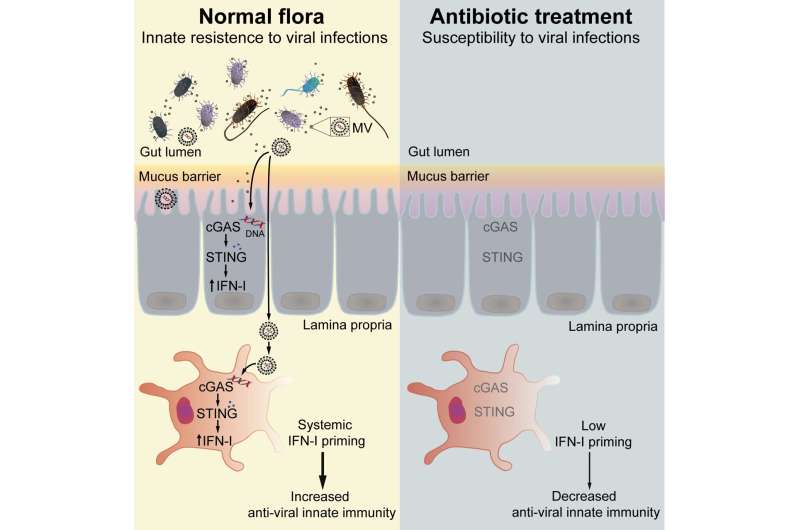The gut microbiota protects against viral infections by keeping the immune system alert

The microbiota is fundamental for health. But how these non-invasive microbes communicate with the rest of the body to influence host physiology is not fully understood. Researchers from Stockholm, Umeå, and Gothenburg Universities, Sweden report how the gut microbiota is essential for natural resistance to viral infections. They show that the release of the membrane vesicles from the gut microbiota leads to the systemic delivery of bacterial DNA to host cells. This triggers the cytosolic cGAS-STING-IFN-I axis for innate immune DNA sensing, thereby protecting distal organs against viral infections. The study is published in the journal Immunity.
The surfaces of all multicellular organisms are constantly populated by commensal microbes, also known as the microbiota, that influence many hosts' physiological processes. The vast majority of these are extracellular bacteria resident within the gut. These microbes are vital for the development and maturation of the immune system. They also protect against bacterial and fungal pathogens by outcompeting them for nutrients or sites of attachment, and by producing antimicrobial substances. But how these non-invasive bacteria within the gut lumen mediate systemic immune modulation and their impact on viral infections is not fully understood.
"We were interested in the influence of gut bacteria on viral infections. So, we treated mice with antibiotics and then infected them with two different types of virus—a DNA virus, herpes simplex virus type 1 (HSV-1), or an RNA virus, vesicular stomatitis virus (VSV). We found that antibiotic treatment made mice more susceptible to these viruses and that this was due to a decrease in basal expression of antiviral immune molecules called the type I interferon (IFN-Is)", Dr. Saskia Erttmann, Umeå University, the first author in the study, says.
The immune system detects microbes via several families of innate receptors. These include the cell surface-localized toll-like receptors (TLRs) that survey the extracellular environment and the cytosolic receptors such as cyclic GMP-AMP Synthase (cGAS) that alert the immune system to the presence of foreign or misplaced DNA inside the cell. Upon sensing DNA, cGAS synthesizes cyclic GMP-AMP (cGAMP), which then signals via the Stimulator of interferon genes (STING) to induce the expression of IFN-Is.
To understand how the microbiota induces basal expression of IFN-Is, the authors analyzed mice defective in different innate immune pathways. They found that induction of IFN-Is by the microbiota involves tonic activation of the cGAS-STING pathway and that this did not require direct bacteria-host cell contact. Consequently, mice ablated in the cGAS-STING-pathway were less responsive to and were more susceptible to HSV-1 and VSV infections.
"Innate immune sensing of extracellular microbes including the gut microbiota is generally assumed to occur via cell surface receptors such as TLRs, while activation of cytosolic immune receptors such as cGAS only occurs in response to invasive DNA viruses, pathogenic bacteria, or parasites equipped with virulence factors allowing them to invade and replicate inside the cell. Thus, the finding that the intracellular cGAS-STING pathway is a sensor of extracellular gut bacteria was unexpected. Moreover, it was unclear to us how gut bacteria, physically separated from host cells by barriers such as the mucus and gut epithelial layer, are nonetheless able to trigger a systemic cGAS-STING-IFN-I response to protect distal organs against viruses," explains Dr. Nelson Gekara, Stockholm University, the senior investigator of the study.
Bacterial membrane vesicles (MVs) are small lipid bilayer vesicles released from bacteria and likely can traverse tissue as well as cell membrane barriers. Therefore, the researchers considered MVs as possible vehicles allowing gut bacteria to deliver DNA into distant host cells thereby mediating a systemic cGAS-STING-IFN-I response. Indeed, they found DNA containing membrane vesicles from gut microbiota were present in blood circulation and when incubated with cells in vitro or inoculated into mice, such MVs promoted the clearance of viruses.
"This study fills an important gap in our understanding of how the gut microbiota mediates systemic immune modulation. They also underscore the underappreciated risk of antibiotics: antibiotics are commonly taken by self-medicating patients to 'treat' undiagnosed illnesses and are sometimes prescribed to patients, as a precaution against bacterial infections that often emerge after viral infection. Our results show that by perturbing the microbiota, antibiotics can adversely impair our ability to fight viral infections. A relevant and perhaps timely message in the current times of a global viral pandemic is that overuse of antibiotics can exacerbate viral infections," concludes Dr. Nelson Gekara.
More information: Saskia F. Erttmann et al, The gut microbiota prime systemic antiviral immunity via the cGAS-STING-IFN-I axis, Immunity (2022). DOI: 10.1016/j.immuni.2022.04.006




















